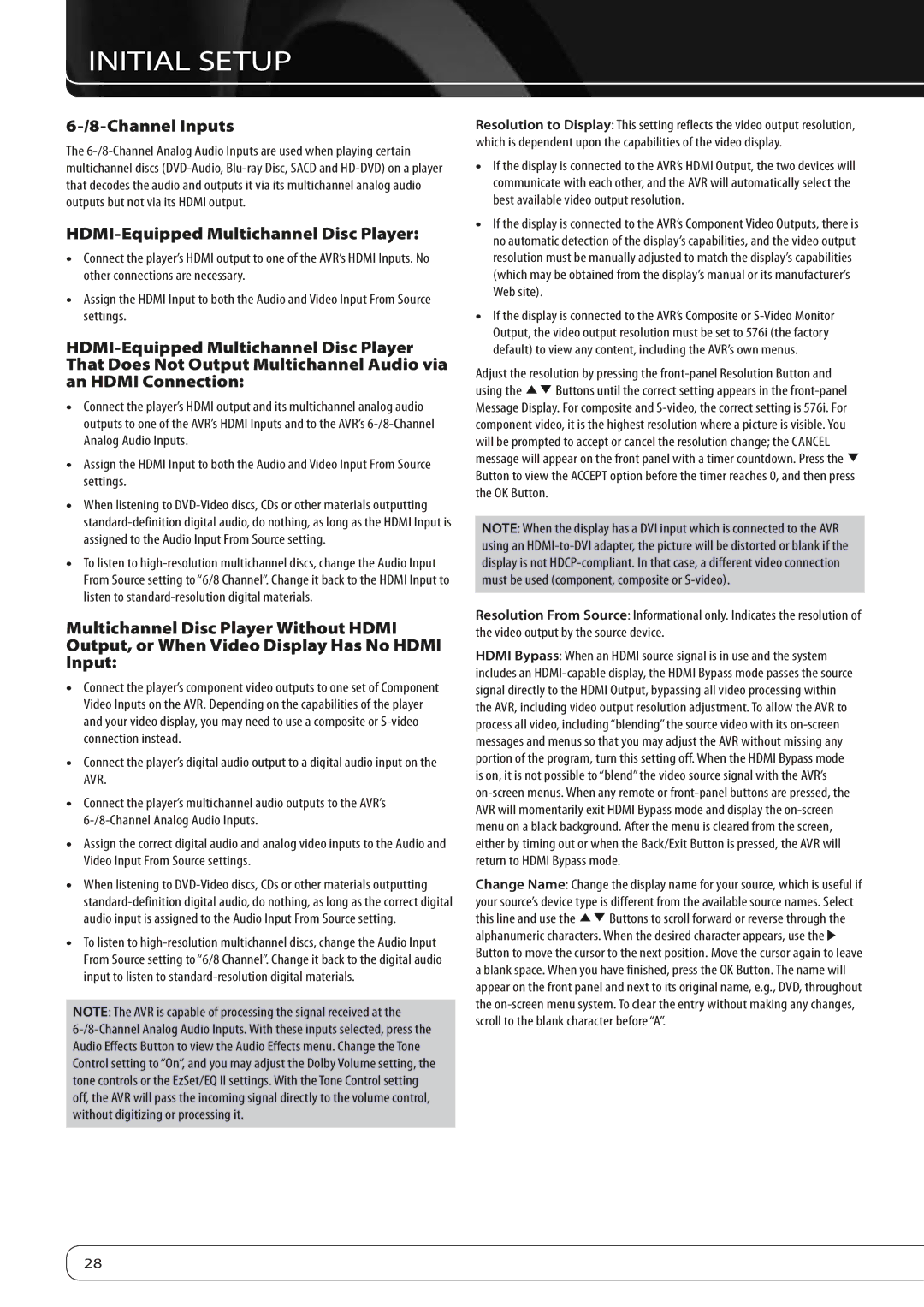6-/8-Channel Inputs
The 6-/8-Channel Analog Audio Inputs are used when playing certain multichannel discs (DVD-Audio, Blu-ray Disc, SACD and HD-DVD) on a player that decodes the audio and outputs it via its multichannel analog audio outputs but not via its HDMI output.
HDMI-Equipped Multichannel Disc Player:
•• Connect the player’s HDMI output to one of the AVR’s HDMI Inputs. No other connections are necessary.
•• Assign the HDMI Input to both the Audio and Video Input From Source settings.
HDMI-Equipped Multichannel Disc Player That Does Not Output Multichannel Audio via an HDMI Connection:
•• Connect the player’s HDMI output and its multichannel analog audio outputs to one of the AVR’s HDMI Inputs and to the AVR’s 6-/8-Channel Analog Audio Inputs.
•• Assign the HDMI Input to both the Audio and Video Input From Source settings.
•• When listening to DVD-Video discs, CDs or other materials outputting standard-definition digital audio, do nothing, as long as the HDMI Input is assigned to the Audio Input From Source setting.
•• To listen to high-resolution multichannel discs, change the Audio Input From Source setting to “6/8 Channel”. Change it back to the HDMI Input to listen to standard-resolution digital materials.
Multichannel Disc Player Without HDMI Output, or When Video Display Has No HDMI Input:
•• Connect the player’s component video outputs to one set of Component Video Inputs on the AVR. Depending on the capabilities of the player and your video display, you may need to use a composite or S-video connection instead.
•• Connect the player’s digital audio output to a digital audio input on the AVR.
•• Connect the player’s multichannel audio outputs to the AVR’s 6-/8-Channel Analog Audio Inputs.
•• Assign the correct digital audio and analog video inputs to the Audio and Video Input From Source settings.
•• When listening to DVD-Video discs, CDs or other materials outputting standard-definition digital audio, do nothing, as long as the correct digital audio input is assigned to the Audio Input From Source setting.
•• To listen to high-resolution multichannel discs, change the Audio Input From Source setting to “6/8 Channel”. Change it back to the digital audio input to listen to standard-resolution digital materials.
NOTE: The AVR is capable of processing the signal received at the
6-/8-Channel Analog Audio Inputs. With these inputs selected, press the Audio Effects Button to view the Audio Effects menu. Change the Tone Control setting to “On”, and you may adjust the Dolby Volume setting, the tone controls or the EzSet/EQ II settings. With the Tone Control setting off, the AVR will pass the incoming signal directly to the volume control, without digitizing or processing it.
Resolution to Display: This setting reflects the video output resolution, which is dependent upon the capabilities of the video display.
•• If the display is connected to the AVR’s HDMI Output, the two devices will communicate with each other, and the AVR will automatically select the best available video output resolution.
•• If the display is connected to the AVR’s Component Video Outputs, there is no automatic detection of the display’s capabilities, and the video output resolution must be manually adjusted to match the display’s capabilities (which may be obtained from the display’s manual or its manufacturer’s Web site).
•• If the display is connected to the AVR’s Composite or S-Video Monitor Output, the video output resolution must be set to 576i (the factory default) to view any content, including the AVR’s own menus.
Adjust the resolution by pressing the front-panel Resolution Button and using the KL Buttons until the correct setting appears in the front-panel Message Display. For composite and S-video, the correct setting is 576i. For component video, it is the highest resolution where a picture is visible. You will be prompted to accept or cancel the resolution change; the CANCEL message will appear on the front panel with a timer countdown. Press the L Button to view the ACCEPT option before the timer reaches 0, and then press the OK Button.
NOTE: When the display has a DVI input which is connected to the AVR using an HDMI-to-DVI adapter, the picture will be distorted or blank if the display is not HDCP-compliant. In that case, a different video connection must be used (component, composite or S-video).
Resolution From Source: Informational only. Indicates the resolution of the video output by the source device.
HDMI Bypass: When an HDMI source signal is in use and the system includes an HDMI-capable display, the HDMI Bypass mode passes the source signal directly to the HDMI Output, bypassing all video processing within the AVR, including video output resolution adjustment. To allow the AVR to process all video, including “blending” the source video with its on-screen messages and menus so that you may adjust the AVR without missing any portion of the program, turn this setting off. When the HDMI Bypass mode is on, it is not possible to “blend” the video source signal with the AVR’s on-screen menus. When any remote or front-panel buttons are pressed, the AVR will momentarily exit HDMI Bypass mode and display the on-screen menu on a black background. After the menu is cleared from the screen, either by timing out or when the Back/Exit Button is pressed, the AVR will return to HDMI Bypass mode.
Change Name: Change the display name for your source, which is useful if your source’s device type is different from the available source names. Select this line and use the KL Buttons to scroll forward or reverse through the alphanumeric characters. When the desired character appears, use the N Button to move the cursor to the next position. Move the cursor again to leave a blank space. When you have finished, press the OK Button. The name will appear on the front panel and next to its original name, e.g., DVD, throughout the on-screen menu system. To clear the entry without making any changes, scroll to the blank character before “A”.

